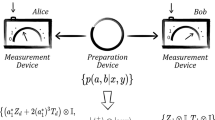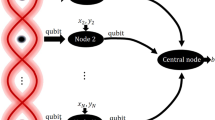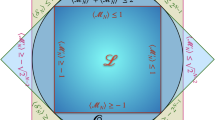Abstract
Certifying quantum properties with minimal assumptions is a fundamental problem in quantum information science. Self-testing is a method to infer the underlying physics of a quantum experiment only from the measured statistics1,2. Although all bipartite pure entangled states can be self-tested3, little is known about how to self-test quantum states of an arbitrary number of systems. Here we introduce a framework of network-assisted self-testing and use it to self-test any pure entangled quantum state of an arbitrary number of systems. The scheme requires the preparation of a number of singlets that scales linearly with the number of systems, and the implementation of standard projective and Bell measurements, all feasible with current technology4. When all the network constraints are exploited, the obtained self-testing certification is stronger than what is achievable in any Bell-type scenario. Our work shows how properly designed networks offer new opportunities for the certification of quantum phenomena.
This is a preview of subscription content, access via your institution
Access options
Access Nature and 54 other Nature Portfolio journals
Get Nature+, our best-value online-access subscription
$29.99 / 30 days
cancel any time
Subscribe to this journal
Receive 12 print issues and online access
$209.00 per year
only $17.42 per issue
Buy this article
- Purchase on Springer Link
- Instant access to full article PDF
Prices may be subject to local taxes which are calculated during checkout



Similar content being viewed by others
Data availability
This work does not have any associated data.
References
Mayers, D. & Yao, A. Self testing quantum apparatus. Quantum Info. Comput. 4, 273–286 (2004).
Šupić, I. & Bowles, J. Self-testing of quantum systems: a review. Quantum 4, 337 (2020).
Coladangelo, A., Goh, K. T. & Scarani, V. All pure bipartite entangled states can be self-tested. Nat. Commun. 8, 15485 (2017).
Wehner, S., Elkouss, D. & Hanson, R. Quantum internet: a vision for the road ahead. Science 362, eaam9288 (2018).
Bell, J. S. On the Einstein Podolsky Rosen paradox. Physics 1, 195–200 (1964).
Eisert, J. et al. Quantum certification and benchmarking. Nat. Rev. Phys. 2, 382–390 (2020).
Fano, U. Description of states in quantum mechanics by density matrix and operator techniques. Rev. Mod. Phys. 29, 74–93 (1957).
Vogel, K. & Risken, H. Determination of quasiprobability distributions in terms of probability distributions for the rotated quadrature phase. Phys. Rev. A 40, 2847–2849 (1989).
Acín, A. et al. Device-independent security of quantum cryptography against collective attacks. Phys. Rev. Lett. 98, 230501 (2007).
Pironio, S. et al. Device-independent quantum key distribution secure against collective attacks. New J. Phys. 11, 045021 (2009).
Colbeck, R. Quantum and Relativistic Protocols for Secure Multi-Party Computation. PhD thesis, Univ. Cambridge (2006); https://arxiv.org/abs/0911.3814
Mayers, D. & Yao, A. Quantum cryptography with imperfect apparatus. In Proc. 39th Annual Symposium on Foundations of Computer Science (cat. no. 98CB36280) 503–509 (IEEE, 1998); https://doi.org/10.1109/sfcs.1998.743501
Summers, S. J. & Werner, R. Maximal violation of Bell’s inequalities is generic in quantum field theory. Commun. Math. Phys. 110, 247–259 (1987).
McKague, M. Self-testing graph states. In Revised Selected Papers of the 6th Conference on Theory of Quantum Computation, Communication, and Cryptography Vol. 6745 (eds Bacon, D. et al.) 104–120 (Springer, 2011); https://doi.org/10.1007/978-3-642-54429-3_7
Wu, X. et al. Robust self-testing of the three-qubit W state. Phys. Rev. A 90, 042339 (2014).
Pál, K. F., Vértesi, T. & Navascués, M. Device-independent tomography of multipartite quantum states. Phys. Rev. A 90, 042340 (2014).
Šupić, I., Coladangelo, A., Augusiak, R. & Acín, A. Self-testing multipartite entangled states through projections onto two systems. N. J. Phys. 20, 083041 (2018).
Baccari, F., Augusiak, R., Šupić, I., Tura, J. & Acín, A. Scalable Bell inequalities for qubit graph states and robust self-testing. Phys. Rev. Lett. 124, 020402 (2020).
Buscemi, F. All entangled quantum states are nonlocal. Phys. Rev. Lett. 108, 200401 (2012).
Branciard, C., Rosset, D., Liang, Y.-C. & Gisin, N. Measurement-device-independent entanglement witnesses for all entangled quantum states. Phys. Rev. Lett. 110, 060405 (2013).
Šupić, I., Hoban, M. J., Colomer, L. D. & Acín, A. Self-testing and certification using trusted quantum inputs. New J. Phys. 22, 073006 (2020).
Bennett, C. H. et al. Remote state preparation. Phys. Rev. Lett. 87, 077902 (2001).
Berry, D. W. & Sanders, B. C. Optimal remote state preparation. Phys. Rev. Lett. 90, 057901 (2003).
Bancal, J.-D., Redeker, K., Sekatski, P., Rosenfeld, W. & Sangouard, N. Self-testing with finite statistics enabling the certification of a quantum network link. Quantum 5, 401 (2021).
Gočanin, A., Šupić, I. & Dakić, B. Sample-efficient device-independent quantum state verification and certification. PRX Quantum 3, 010317 (2022).
Coladangelo, A. Parallel self-testing of (tilted) EPR pairs via copies of (tilted) CHSH and the magic square game. Quantum Inf. Comput. 17, 831–865 (2017).
Clauser, J. F., Horne, M. A., Shimony, A. & Holt, R. A. Proposed experiment to test local hidden-variable theories. Phys. Rev. Lett. 23, 880–884 (1969).
Bowles, J., Šupić, I., Cavalcanti, D. & Acín, A. Self-testing of Pauli observables for device-independent entanglement certification. Phys. Rev. A 98, 042336 (2018).
Wu, X., Bancal, J.-D., McKague, M. & Scarani, V. Device-independent parallel self-testing of two singlets. Phys. Rev. A 93, 062121 (2016).
Coudron, M. & Natarajan, A. The parallel-repeated magic square game is rigid. Preprint at https://arxiv.org/abs/1609.06306 (2016).
McKague, M. Self-testing in parallel with CHSH. Quantum 1, 1 (2017).
Natarajan, A. & Vidick, T. A quantum linearity test for robustly verifying entanglement. In Proc. 49th Annual ACM SIGACT Symposium on Theory of Computing, STOC 2017 1003–1015 (Association for Computing Machinery, 2017); https://doi.org/10.1145/3055399.3055468
Branciard, C., Gisin, N. & Pironio, S. Characterizing the nonlocal correlations created via entanglement swapping. Phys. Rev. Lett. 104, 170401 (2010).
Fritz, T. Beyond Bell’s Theorem II: scenarios with arbitrary causal structure. Commun. Math. Phys. 341, 391–434 (2015).
Renou, M.-O. et al. Genuine quantum nonlocality in the triangle network. Phys. Rev. Lett. 123, 140401 (2019).
Šupić, I., Bancal, J.-D. & Brunner, N. Quantum nonlocality in networks can be demonstrated with an arbitrarily small level of independence between the sources. Phys. Rev. Lett. 125, 240403 (2020).
Tavakoli, A., Pozas-Kerstjens, A., Luo, M.-X. & Renou, M.-O. Bell nonlocality in networks. Rep. Prog. Phys. 85, 056001 (2022).
Renou, M.-O. et al. Quantum theory based on real numbers can be experimentally falsified. Nature 600, 625–629 (2021).
Bădescu, C., O’Donnell, R. & Wright, J. Quantum state certification. In Proc. 51st Annual ACM SIGACT Symposium on Theory of Computing, STOC 2019, 503–514 (Association for Computing Machinery, 2019); https://doi.org/10.1145/3313276.3316344
Bancal, J.-D., Sangouard, N. & Sekatski, P. Noise-resistant device-independent certification of Bell state measurements. Phys. Rev. Lett. 121, 250506 (2018).
Renou, M.-O., Kaniewski, J. & Brunner, N. Self-testing entangled measurements in quantum networks. Phys. Rev. Lett. 121, 250507 (2018).
Morris, J., Saggio, V., Gočanin, A. & Dakić, B. Quantum verification and estimation with few copies. Adv. Quantum Technol. 5, 2100118 (2022).
Yang, T. H., Vértesi, T., Bancal, J.-D., Scarani, V. & Navascués, M. Robust and versatile black-box certification of quantum devices. Phys. Rev. Lett. 113, 040401 (2014).
Reichardt, B. W., Unger, F. & Vazirani, U. Classical command of quantum systems. Nature 496, 456–460 (2013).
Coladangelo, A., Grilo, A. B., Jeffery, S. & Vidick, T. Verifier-on-a-leash: new schemes for verifiable delegated quantum computation, with quasilinear resources. In Advances in Cryptology – EUROCRYPT 2019 (eds Ishai, Y. & Rijmen, V.) 247–277 (Springer, 2019).
McKague, M. Interactive proofs for BQP via self-tested graph states. Theory Comput. 12, 1–42 (2016).
Acknowledgements
This work was funded by the ERC through grants QUSCO (I.Š.) and AdG CERQUTE, (A.A.), grant PCI2021-122022-2B financed by MCIN/AEI/10.13039/501100011033 (M.-O.R.), the European Union Next Generation EU/PRTR (M.-O.R.), a Swiss National Fund Early Mobility Grant P2GEP2_19144 (M.-O.R.), a FQXi large grant FQXi-RFP-1803B (M.J.H.), the Government of Spain through grants FIS2020-TRANQI (A.A.), Retos Quspin (A.A.), NexGen Funds (A.A.) and Severo Ochoa CEX2019-000910-S (A.A.), Fundacio Cellex (A.A.), Fundacio Mir-Puig, (A.A.), Generalitat de Catalunya through grants CERCA (A.A.), the QuantERA II Programme through grant Veriqtas (A.A.), and QuantumCAT (A.A.), and the AXA Chair in Quantum Information Science (A.A.).
Author information
Authors and Affiliations
Contributions
All authors contributed equally to this work.
Corresponding author
Ethics declarations
Competing interests
The authors declare no competing interests.
Peer review
Peer review information
Nature Physics thanks Anna Pappa, Arthur Mehta and Petros Wallden for their contribution to the peer review of this work.
Additional information
Publisher’s note Springer Nature remains neutral with regard to jurisdictional claims in published maps and institutional affiliations.
Supplementary information
Supplementary Information
Supplementary Discussion and Figs. 1–3.
Rights and permissions
Springer Nature or its licensor (e.g. a society or other partner) holds exclusive rights to this article under a publishing agreement with the author(s) or other rightsholder(s); author self-archiving of the accepted manuscript version of this article is solely governed by the terms of such publishing agreement and applicable law.
About this article
Cite this article
Šupić, I., Bowles, J., Renou, MO. et al. Quantum networks self-test all entangled states. Nat. Phys. 19, 670–675 (2023). https://doi.org/10.1038/s41567-023-01945-4
Received:
Accepted:
Published:
Issue Date:
DOI: https://doi.org/10.1038/s41567-023-01945-4
This article is cited by
-
Trust your network with entanglement
Nature Physics (2023)



